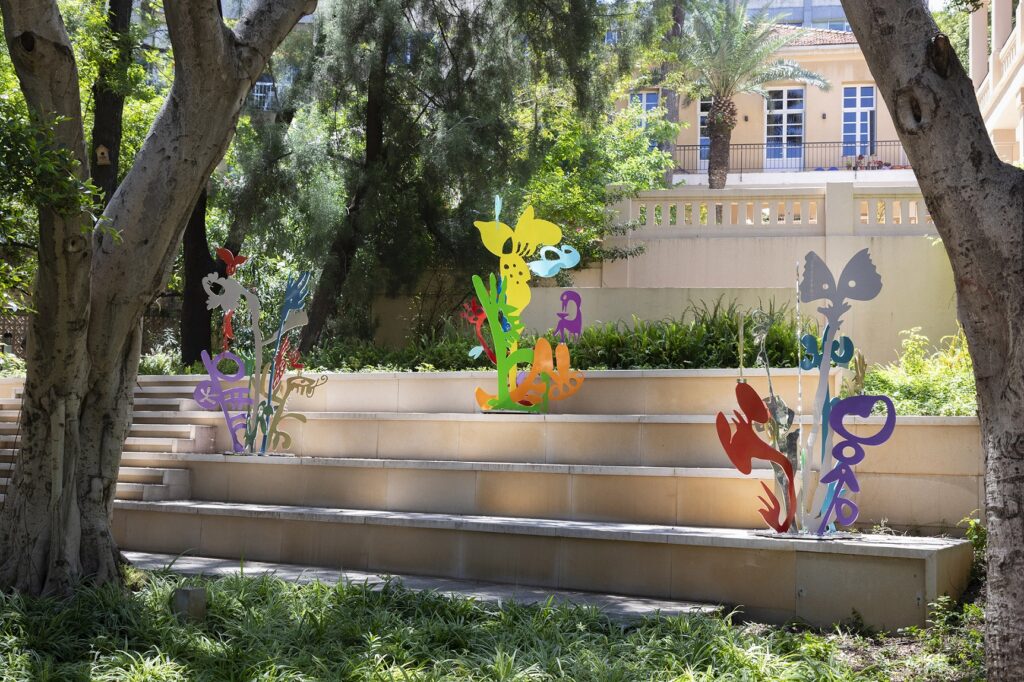“The Carrier” – The Carrier, National Museum of Beirut
Hiroshi Hara, Architect and Professor, Institute of Industrial Science, University of Tokyo
Published in The Carrier, Nadim Karam & Atelier Hapsitus, 1995
Nadim Karam came to Japan, carrying the air of war from Lebanon with him. Then again, I could say it like this; Nadim Karam was transported here from the deepest reaches of the Middle East.
From that time, he began to draw mysterious pictures. The shapes and colors were, geographically speaking, a hybrid of Egypt and the Orient, and psychologically speaking, an image of war equaling death. These two overlapping images brought it mind the ancient rites of a dynasty.
What exactly was the war that took place in Lebanon in the latter half of the 20th century all about? Even though I have listened to Nadim talking about it on several occasions, I still can’t really grasp the meaning. If the various contradictions in the history of the world found necessary expression in war, then that war undoubtedly took place in Lebanon. Not being able to return home, Nadim brought a cow with him to his performing stage. In Paris, he wants to carry a giraffe. How does this transportation tie in with death rites at the time when the Phoenicians lived in peace in the Middle East, or indeed with the time that the Abu Simbel statues of deities were built?
Nadim Karam wrote is doctor’s thesis. The theme was the stage temp0les in Japan. As this was the place of ceremonious performances, his was also the study of a uniquely Japanese architecture. In order to do this, Nadim began his research with the Omizutori rite of Todaiji Temple’s Nigatsudo hall. Then he conducted 40 local architectural surveys. Today, however, it is almost impossible to see this ritual, and so it remains, traced in an architectural form, the image of a formerly enacted ritual. Nadim Karam immediately understood the multiplicity of the Oriental outlook. Taking Istanbul, for example, you will find that it describes itself as Asia. I am not saying that Lebanon is close to the Orient, but when you go to Istanbul from Lebanon you have to travel further to the west, although Lebanon is not neighboring Asia. The altar of Israel is close by, as are the pyramids of the Sahara, and in about the same place are the ruins of Aleppo, and on the other side of the desert the Tiberis Euphrates flows. There the war is bogged down and muddied in confusion, and it is no longer clear who is friend and who is foe. Every squad of guerillas act completely independently; carrying out kidnappings- they call it “transportation”- all over the place. Although this situation is becoming more and more chaotic, its origins are also confused. They are reflected in its special geographical characteristics, and in the far-reaching haze of history widening beyond. Even the shadow cast by Nadim is multi-layered.
A taste for imagery you might say. The man who carries images. At one time, when devastation from the war was severe, he sneaked into Beirut from the dubious country Cyprus in disguise. Then, bringing back concepts and ritualistic images, with the same kind of sketches and even a
matching appearance; he put a cow in his performance and painted a picture that looked like an X- ray. At the beginning, Nadim’s pictures were like darkly muddied like Beirut, and archaic like ancient Middle Eastern murals. Recently, they have almost come to seem transparent. Maybe it is the feeling than more than bringing a cow to Tokyo, carrying a giraffe in Paris is more ephemeral. This tendency towards being a master of transparency gives anticipation of even further evolution. This can be seen in his sketch, “The Carrier”.
What meaning does Japan hold for Nadim Karam? At present, I don’t think this is yet visible enough in his style of expression. He has been in Japan (already 8 or 9 years, I guess), and has seen the Middle East, New York and Paris. The world is changing; there are indications that colors of nationalism are steadily strengthening, and I think it was well for Nadim to be able to extricate himself from Lebanon, where religious divisions cannot be suppressed. I say this because it is clear that this cannot be resolved in the contradictions that are becoming evident in many countries of the world. According to Nadim when I talked to him the other day, the situation is changing in Beirut, and it is now becoming possible to conduct work there. Undoubtedly, when he returns to Beirut,
Japan will become more clearly visible inside him. From the perspective of his teacher, I would like him to take what he has learned from the stage temples to Beirut, Paris and to New York for me.
The metaphor, a quintessential art, contains the meaning of “carrying” in its etymology. What is indispensable in this carrying process is to carry far; carrying unexpected things to unexpected places. I’m looking forward to seeing Nadim Karam’s splendid carriage.
